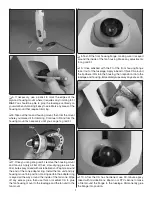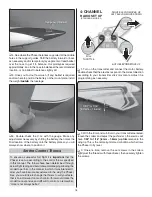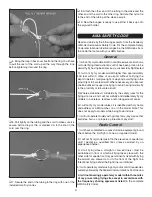
23
Stretch out the bungee, walking fi fteen to twenty steps away downward, from the stake. Then connect it to the hook on the
bottom of the plane. If using an assistant, inform him of your intentions and make sure he acknowledges, then go to full
throttle. Holding the Phazer at an approximately 30 degree angle, wings level,
give it a good push into the air
and let go.
The Phazer should lunge forward. Then it may descend slightly before it gets up to fl ying speed—this will all happen in about
a second, so you need to get your fi ngers back on the sticks right away! Fly the Phazer out of the launch and the bungee
will automatically release.
After you get a few bungee launches under your belt the only hard part will be remembering to wind it back up and bring it
back home with you!
Throw the Phazor underhanded
− focus on keeping the wings level.
With hand-launching, the main hurdle to overcome will be fl ying speed—the bungee gets the Phazer up to speed right away,
but the Phazer has to fl y away from a hand-launch and build speed on its own.
Whether the pilot or an assistant, hold the Phazer over the top of the fuselage so it can be thrown in an underhand fashion.
Though it is important to throw the Phazer hard, concentrate more on throwing it with the wings level and the nose pointed
up at about a 20 – 30-degree angle. When ready, go to full-throttle, then throw the Phazer into the air. Remember to focus on
keeping the wings level. Initially, the Phazer will have little fl ying speed, so the pilot won’t have much control (emphasizing the
importance of a good launch). The Phazer will gradually build up enough speed and fl y away, but as long as the wings are
level the worst thing that will happen is it will simply land! If the launch was poor and the wings are not level you have to hope
it can gain enough airspeed to fl y out of it. Otherwise your Phazer may go in with the wings banked, possibly causing damage.
Factors that help the hand-launch are launching on high rates, having the C.G. anywhere between the recommended location
and the aft location, and launching into a headwind. Same as with the bungee-launch, it’s best to have an assistant hand-
launch the Phazer the fi rst time so you will know what to expect when you’re ready to try it yourself.
Bungee launches are consistent because most of the human factor has been taken out. But human error can cause the
hand-launch to go wrong, so make sure you (or your assistant) know what they’re doing before trying a hand-launch.
With a good launch the Phazer will eventually gain speed and easily fl y away. Then you’ll wonder what all the fuss was about!


































